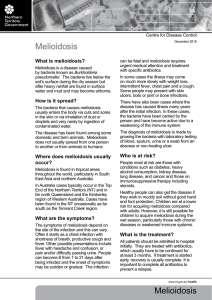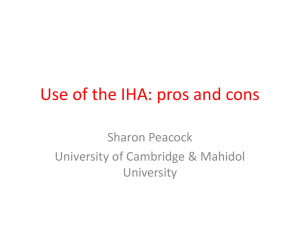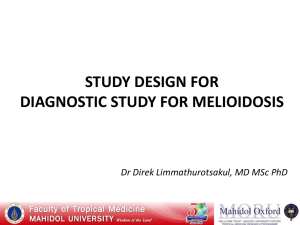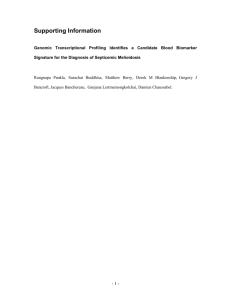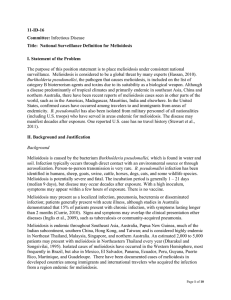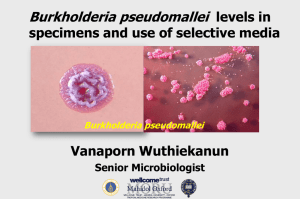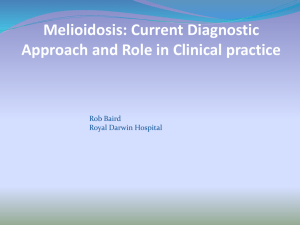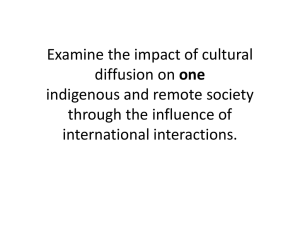PPT Limmathurotsakul 01
advertisement
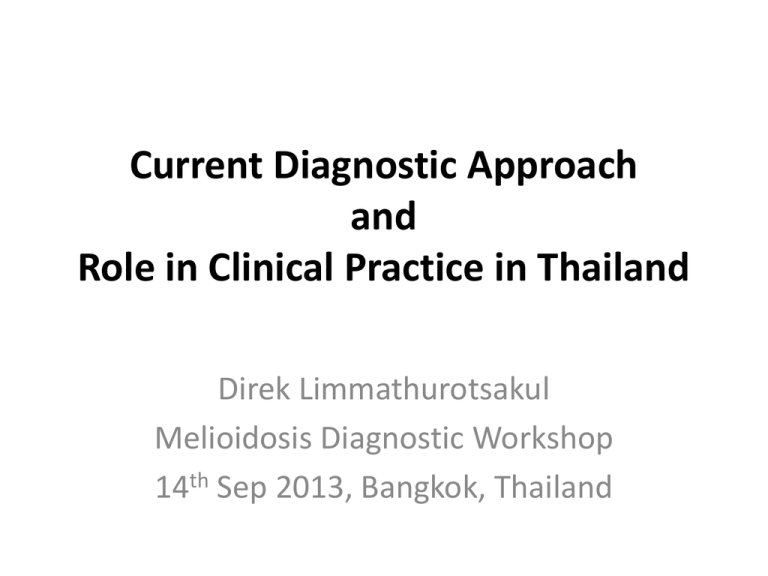
Current Diagnostic Approach and Role in Clinical Practice in Thailand Direk Limmathurotsakul Melioidosis Diagnostic Workshop 14th Sep 2013, Bangkok, Thailand Thailand 76 provinces - Each has one large provincial hospital (200 to 1,000 beds) 928 districts - Each has one small provincial hospital (30 to 150 beds) What policy makers saw Melioidosis is a disease that needs to report to Ministry of Public Health, Thailand, via Report 506 Melioidosis Melioidosis Case Classification (defined by MoPH, Thailand, 2001) • Suspected case: None • Probable case: Clinical criteria plus one IHA ≥ 1:160 • Confirmed case: Clinical criteria plus bacterial culture positive for B. pseudomallei or IHA four-fold rising Clinical criteria • High fever with localized infection, septicaemia, or septic shock without culture positive for other pathogenic organisms Official Data for Total Number of Melioidosis in Thailand, Bureau of Epidemiology, MoPH 3,929 Number of cases and of fatal cases (log scale) 10000 2,902 3,631 1,350 1000 360 402 421 651 920 1,098 100 10 6 7 8 8 11 15 10 14 5 Impossible! How come? 2 1 03 04 05 06 07 08 09 10 11 12 Year (AD) melioidosis case fatal melioidosis case www.boe.moph.go.th/boedb/surdata/506wk/y56/en/d72_3256_en.pdf Conclusion 1 - IHA • IHA is available in nearly every hospital in Thailand • A lot of melioidosis cases in Thailand are (falsely) diagnosed by IHA ≥ 1:160 or four-fold rise of IHA • We found that standardization of IHA is problematic, and some community hospitals gave a number of false positive results • Most doctors in Thailand believe that IHA is a good diagnostic test without knowing its problem of poor sensitivity and specificity What researchers saw B. pseudomallei is commonly isolated from clinical specimens in NE, East, West and South Thailand • In 2008, there were 2,557 culture-confirmed melioidosis cases in NE Thailand 1 • There are regular report of melioidosis in South of Thailand 2 • Between 2006-10, there were 8, 50, 76 and 151 culture-confirmed melioidosis in 4 provinces in West and East Thailand 3 • In 1999, there was a report of 100 and 127 cultureconfirmed melioidosis patients in North and Central Thailand 2 (1) Wongratanacheewin (IS-02), World Melioidosis Congress 2013 (2) Chusri et al. AJTMH (2012) 87(5): 927-32 (3) Limmathurotsakul et al. EID (2012) 18(2): 325-7 (4) Vuddhakul et al. AJTMH (1999) 60(3): 458-61 B. pseudomallei is commonly isolated from clinical specimens in NE, East, West and South Thailand • B. pseudomallei is the second most common cause of community-acquired bacteremia in NE Thailand 2 • In short, researchers estimate that there are >2,500 culture-confirmed melioidosis cases per year • Overall mortality of culture-confirmed melioidosis is about 40% 1,2 (1) Limmathurotsakul et al. AJTMH (2010) 82(6): 1113-7 (2) Kanoksil et al. PLoS One (2013) 8(1) e54714 New Melioidosis Case Classification (developed by researchers, and proposed to MoPH, 2013) • Suspected case: None • Probable case: None • Confirmed case: Any case with bacterial culture positive for B. pseudomallei • New study under collaboration between Faculty of Tropical Medicine and Bureau of Epidemiology, MoPH, Thailand is going to revise the official data of melioidosis in Thailand using the routine culture result of all microbiological laboratories in all provincial hospitals in Thailand Conclusion 2 - Culture • Microbiology facilities are available in all 76 provincial hospitals in Thailand, university hospitals, large private hospitals, and private commercial laboratories • Nonetheless, culture is not available in most community hospitals (928 community hospitals) • Identification of B. pseudomallei is still a problem • We found that many microbiological laboratories do not aware of B. pseudomallei and stop bacterial identification at Pseudomonas spp. • Some also discard B. pseudomallei as contamination What researchers did B. pseudomallei selective media • Broth (Ashdown broth, TBSS-C50,..) • Agar (Ashdown agar, BPSA, B. cepacia medium, ..) • Proved to be cost-effective, easy to prepare, improve colony detection, stop other flora in non-sterile specimens • Unfortunately, it is not formally recommended by any government documents or policies. • Only available in few research facilities (UBON and KK) (1) Peacock et at JCM(2005) 43(10) 5350-5361 Latex Agglutination (LA) • Based on Monoclonal Ab specific to 200-kDa EPS B. pseudomallei 1 • Very useful, easy to use, and highly sensitive and highly specific • Recommended to be used for any Gram-negative bacillus that is oxidase +ve and not P. aeruginosa • Unfortunately, it is neither available for commercial use nor from governmental agencies. • Only available in few research facilities (UBON and KK) (1) Wuthiekanun et al AJTMH (2002) 66(6) 759-761 Immunofluorescent Assay (IFA) • Based on Monoclonal Ab to EPS 1 • Moderately sensitive but highly specific • Use in clinical specimen directly • Need IF microscopy. Less sensitive than culture. • Patients whom melioidosis is suspected should be treated for at least 4-7 days anyway (until culture result is available) • Available only in UBON (1) Narisara et al AJTMH (2013) Epub ahead of print Current Diagnostic Approach in Thailand (In general, countrywide) • Use clinical criteria (which is neither sensitive nor specific) • Start treatment if melioidosis is suspected by the clinical criteria • Order lab test for IHA • Order blood culture with or without culture of other clinical specimens • No selective media for B. pseudomallei is used • No latex agglutination is used • Diagnose melioidosis based on clinical criteria, IHA or culture Recommended Diagnostic Approach in Thailand (Used in Research Facilities / Settings [1]) • Use empirical treatment regimen to cover B. pseudomallei (e.g. Cloxacillin + Ceftazidime) in areas where melioidosis is present for all sepsis and severe sepsis patients (unless definite diagnosis of other diseases is made e.g. malaria, measles, ..) • Ignore IHA • Order blood, urine and throat swab culture • Order pus and sputum culture if available • Confirm laboratory that “selective media for B. ps” and “latex agglutination” are used • Order Ultrasound for abdomen (or CT scan if possible) Recommended Diagnostic Approach in Thailand (Used in Research Facilities / Settings [2]) • Re-evaluate patients daily, search for abscesses and collect more clinical specimens for culture if available • Definite melioidosis = culture +ve (report only this group to MoPH) • Probable melioidosis = abscesses that is consistent with melioidosis but culture was not done or negative, or culture negative for B. ps and represent within 1 month with culture-proven melioidosis • Possible melioidosis = clinically suspected melioidosis and improved after treatment with an effective antimicrobial regimen for melioidosis or died before improvement was observed (1) Cheng et al AJTMH (2013) 88(3) 411-413 Conclusion • There is a big gap between current and recommended diagnostic approaches for melioidosis in Thailand • Simply lab tests and consumables such as B. ps selective media and latex agglutination need to be commercially available and supported by the government policy • New, rapid, simple, validated and accurate diagnostic tests are still required, and a combination of antigen and antibody detection is preferred END

